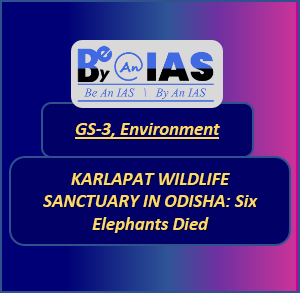CURRENT AFFAIRS
Get the most updated and recent current affair content on Padhaikaro.com
KARLAPAT WILDLIFE SANCTUARY IN ODISHA: Six Elephants Died
- Be N By IAS, Delhi
- 16, Feb 2021

For : GS-3: Environment
CONTEXT:
- After six elephants died in just 14 days at Karlapat Wildlife Sanctuary in Odisha’s Kalahandi district, Chief Minister Naveen Patnaik asked the authorities to take immediate measures to stop the fatalities.

NEWS IN DETAILS:
- Fatalities: Four female pachyderms and a calf have died there since February 1. Later one more female elephant was found dead near a waterbody in the Karlapat Wildlife Sanctuary.
- Total Elephants: According to the 2018 census the sanctuary had 17 elephants.
- Reason of Death: “The death of elephants is due to Haemorrhage Septicemia (HS),” the DFO said.
- The postmortem report and laboratory report of one dead elephant is hinting at HS.”
- This is perhaps the first incident where elephants are also infected with HS.
- However, no death of other animals in the sanctuary happened.
- But Cattle get infected by HS if not vaccinated
POINT OF ACTION:
- Vaccination of villages cattles: CM directed the district administration of Kalahandi and the DFO to ensure vaccination of cattle in villages close to the sanctuary.
- Disinfect water bodies: All the water bodies in the sanctuary should be disinfected and water samples should be sent to labs for tests.
- There are at least 43 water bodies in the sanctuary of which 25 have been disinfected so far.
KARLAPAT WILDLIFE SANCTUARY:
- Karlapat Wildlife Sanctuary is spread over 175 square kilometre area.
- It was notified in 1992 under the Wildlife Protection Act of 1972.
- Forest Region: Lush green dry deciduous forest within Eastern Highlands moist deciduous forests eco-region.
- A beautiful waterfall,'Phurlijharan' has been developed as a picnic spot
- Fauna:
- Mammal: Elephant, leopard, Gaur, Sambar, barking deer, Indian wolf, wild dog, wild pig, sloth bear, Malbar giant squirrel and Pangolin.
- Birds: Peafowl, peacock, hornbill, Red jungle fowl, partridges, Spurfawl, Hill Myna, Brahminy kite
- Reptiles: Mugger, crocodile, monitor lizard, snakes both poisonous and non-poisonous
- Flora: Sal, Bija, Asan, Harida, Amala, Bahada and Bamboo and varieties of medicinal plants.
HAEMORRHAGE SEPTICEMIA (HS):
- Hemorrhagic septicemia is a severe bacterial disease.
- Haemorrhagic septicaemia in cattle and buffaloes was previously known to be associated with one of two serotypes of P. multocida: Asian B:2 and African E:2.
- Infected Species: The disease occurs mainly in cattle and buffaloes.
- But has also been reported in goats, African buffalo, camels, horses, pigs and in wild elephants
- Spread:
- Through contact with infected animals,
- Contaminated clothes & equipment
- Ingestion or inhalation of the bacteria.
- Symptoms: Undigested food in faeces, swishing tail, reduced cudding reduced milk yield.
- Prevent: Burring the carcasses of infected animals in deep pits will prevent the spread of the disease.
SOURCE: Indian Express
MCQs:
Q. Karlapat Wildlife Sanctuary is located in:
- a) West Bengal
- b) Andhra Pradesh
- c) Odisha
- d) Maharashtra
ANS: C